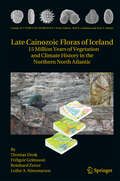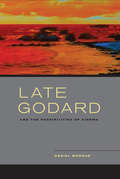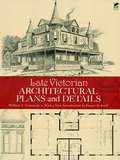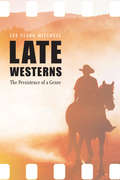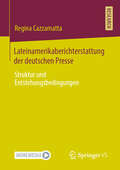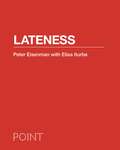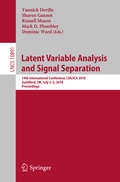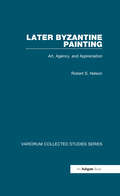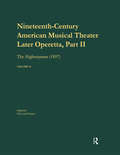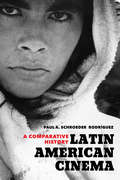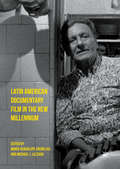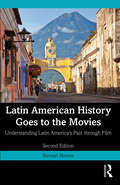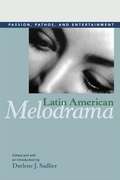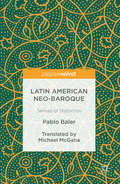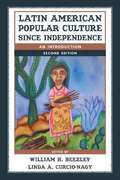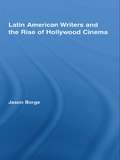- Table View
- List View
Late Cainozoic Floras of Iceland
by Friðgeir Grimsson Leifur A. Símonarson Reinhard Zetter Thomas DenkBeing the only place in the northern North Atlantic yielding late Cainozoic terrestrial sediments rich in plant fossils, Iceland provides a unique archive for vegetation and climate development in this region. This book includes the complete plant fossil record from Iceland spanning the past 15 million years. Eleven sedimentary rock formations containing over 320 plant taxa are described. For each flora, palaeoecology and floristic affinities within the Northern Hemisphere are established. The exceptional fossil record allows a deeper understanding of the role of the "North Atlantic Land Bridge" for intercontinental plant migration and of the Gulf Stream-North Atlantic Current system for regional climatic evolution. 'Iceland sits as a "fossil trap" on one of the most interesting biogeographic exchange routes on the planet - the North Atlantic. The fossil floras of Iceland document both local vegetational response to global climate change, and more importantly, help to document the nature of biotic migration across the North Atlantic in the last 15 million years. In this state-of-the-art volume, the authors place sequential floras in their paleogeographic, paleoclimatic and geologic context, and extract a detailed history of biotic response to the dynamics of physical change.' Bruce H. Tiffney, University of California, Santa Barbara 'This beautifully-illustrated monograph of the macro- and microfloras from the late Cenozoic of Iceland is a worthy successor to Oswald Heer's "Flora fossilis arctica". Its broad scope makes it a must for all scientists interested in climatic change and palaeobiogeography in the North Atlantic region. It will remain a classic for years to come.' David K. Ferguson, University of Vienna
Late Godard and the Possibilities of Cinema
by Daniel MorganWith Late Godard and the Possibilities of Cinema, Daniel Morgan makes a significant contribution to scholarship on Jean-Luc Godard, especially his films and videos since the late 1980s, some of the most notoriously difficult works in contemporary cinema. Through detailed analyses of extended sequences, technical innovations, and formal experiments, Morgan provides an original interpretation of a series of several internally related films--Soigne ta droite (Keep Your Right Up, 1987), Nouvelle vague (New Wave, 1990), and Allemagne 90 neuf zéro (Germany 90 Nine Zero, 1991)--and the monumental late video work, Histoire(s) du cinéma (1988-1998). Taking up a range of topics, including the role of nature and natural beauty, the relation between history and cinema, and the interactions between film and video, the book provides a distinctive account of the cinematic and intellectual ambitions of Godard's late work. At the same time, Late Godard and the Possibilities of Cinema provides a new direction for the fields of film and philosophy by drawing on the idealist and romantic tradition of philosophical aesthetics, which rarely finds an articulation within film studies. In using the tradition of aesthetics to illuminate Godard's late films and videos, Morgan shows that these works transform the basic terms and categories of aesthetics in and for the cinema.
Late Star Trek: The Final Frontier in the Franchise Era (Mass Markets: Storyworlds Across Media)
by Adam KotskoHow Star Trek&’s twenty-first-century reinventions illuminate the unique challenges and opportunities of franchise-style corporate storytellingLate Star Trek explores the beloved science fiction franchise&’s repeated attempts to reinvent itself after the end of its 1990s golden age. Beginning with the prequel series Enterprise, Adam Kotsko analyzes the wealth of content set within Star Trek&’s sprawling continuity—including authorized books, the three &“Kelvin Timeline&” films, and the streaming series Discovery, Picard, Lower Decks, Prodigy, and Strange New Worlds—along with fan discourse, to reflect on the perils and promise of the franchise as a unique form of storytelling. Significantly including the licensed novels and comic books that fill out the Star Trek universe for its fans, Kotsko brings the multiple productions of the early twenty-first century together as a unified whole rather than analyzing them in their current stratified view. He argues that the variety of styles and approaches in this tumultuous era of Star Trek history provides the perfect opportunity to reflect on the nature of the franchise storyworlds that now dominate popular culture. By taking the spin-offs and tie-ins seriously as creative attempts to tell a new story within an established universe, Late Star Trek highlights creative triumphs as well as the tendency for franchise faithfulness to get in the way of creating engaging characters and ideas. Arguing forcefully against the prevailing consensus that franchises are a sign of cultural decay, Kotsko contends that the Star Trek universe exemplifies an approach to storytelling that has been perennial across cultures. Instead, he finds that what limits creativity within franchises is not their reliance on the familiar but their status as modern myths, held not as common cultural heritage but rather owned as corporate intellectual property. Retail e-book files for this title are screen-reader friendly with images accompanied by short alt text and/or extended descriptions.
Late Victorian Architectural Plans and Details (Dover Architecture)
by William T. Comstock Daniel D. ReiffThis authentic reproduction of plans drawn up by a noted nineteenth-century architectural firm features both residential and public buildings. Hundreds of illustrations include floor plans, perspective views, and elevations as well as designs for staircases, fireplaces, and other interior details. Other drawings depict windows, doors, balconies, and gables. Photographs offer crisp views of exteriors. Victorian architecture buffs will prize this excellent source of authentic period designs. Its 126 plates comprise 87 images of residences; the remaining 39 structures include a field club building, stables, a library, a school, a railroad station, a dry goods store, and a music hall. Captions describe locations, dimensions, costs, and other particulars.
Late Westerns: The Persistence of a Genre (Postwestern Horizons)
by Lee Clark MitchellFor more than a century the cinematic Western has been America’s most familiar genre, always teetering on the verge of exhaustion and yet regularly revived in new forms. Why does this outmoded vehicle—with the most narrowly based historical setting of any popular genre—maintain its appeal? In Late Westerns Lee Clark Mitchell takes a position against those critics looking to attach “post” to the all-too-familiar genre. For though the frontier disappeared long ago, though men on horseback have become commonplace, and though films of all sorts have always, necessarily, defied generic patterns, the Western continues to enthrall audiences. It does so by engaging narrative expectations stamped on our collective consciousness so firmly as to integrate materials that might not seem obviously “Western” at all. Through plot cues, narrative reminders, and even cinematic frameworks, recent films shape interpretive understanding by triggering a long-standing familiarity audiences have with the genre. Mitchell’s critical analysis reveals how these films engage a thematic and cinematic border-crossing in which their formal innovations and odd plots succeed deconstructively, encouraging by allusion, implication, and citation the evocation of generic meaning from ingredients that otherwise might be interpreted quite differently. Applying genre theory with close cinematic readings, Mitchell posits that the Western has essentially been “post” all along.
Lateinamerikaberichterstattung der deutschen Presse: Struktur und Entstehungsbedingungen
by Regina CazzamattaDas vorliegende Buch zu Struktur und Entstehungsbedingung Lateinamerikas in der deutschen Presse basiert auf einer in dieser Dimension bis heute nicht vorhandenen empirischen Grundlage. Die Studie basiert auf 21.929 Beiträgen, von denen mithilfe einer geschichteten Stichprobe 4.164 in die Analyse einbezogen, ausgewertet und mit Korrespondenten-Interviews kombiniert wurden. Sie beleuchtet die Auswahlkriterien und Mechanismen der Berichterstattung zu Lateinamerika und füllte eine Forschungslücke zu einem Thema, das außenpolitisch extrem relevant ist. Das Buch betrachtet Themen und Merkmale des Mediendiskurses in kombinierter Form, stellt Länderprofile dar und sucht nach theoretischen Erklärungen für die Bildkonstruktionen. Die Studie kommt zum Ergebnis, dass es das Lateinamerikabild in der deutschen Presse nicht gibt, sondern sich eine Perzeption nach Ländern und Landesgruppen ausdifferenziert lässt. Die Forschungsarbeit ist über das Fachgebiet Medien- und Kommunikationswissenschaft hinaus interessant und bedeutet einen Gewinn für die Lateinamerikaforschung in Deutschland.
Lateness (POINT: Essays on Architecture #2)
by Peter Eisenman Elisa IturbeA provocative case for historical ambiguity in architecture by one of the field's leading theoristsConceptions of modernity in architecture are often expressed in the idea of the zeitgeist, or "spirit of the age," an attitude toward architectural form that is embedded in a belief in progressive time. Lateness explores how architecture can work against these linear currents in startling and compelling ways. In this incisive book, internationally renowned architect Peter Eisenman, with Elisa Iturbe, proposes a different perspective on form and time in architecture, one that circumvents the temporal constraints on style that require it to be "of the times"—lateness. He focuses on three twentieth-century architects who exhibited the qualities of lateness in their designs: Adolf Loos, Aldo Rossi, and John Hejduk. Drawing on the critical theory of Theodor Adorno and his study of Beethoven's final works, Eisenman shows how the architecture of these canonical figures was temporally out of sync with conventions and expectations, and how lateness can serve as a form of release from the restraints of the moment.Bringing together architecture, music, and philosophy, and drawing on illuminating examples from the Renaissance and Baroque periods, Lateness demonstrates how today's architecture can use the concept of lateness to break free of stylistic limitations, expand architecture's critical capacity, and provide a new mode of analysis.
Lateness and Longing: On the Afterlife of Photography (Abakanowicz Arts and Culture Collection)
by George BakerHow a generation of women artists is transforming photography with analogue techniques. Beginning in the 1990s, a series of major artists imagined the expansion of photography, intensifying its ideas and effects while abandoning many of its former medium constraints. Simultaneous with this development in contemporary art, however, photography was moving toward total digitalization. Lateness and Longing presents the first account of a generation of artists—focused on the work of Zoe Leonard, Tacita Dean, Sharon Lockhart, and Moyra Davey—who have collectively transformed the practice of photography, using analogue technologies in a dissident way and radicalizing signifiers of older models of feminist art. All these artists have resisted the transition to the digital in their work. Instead—in what amounts to a series of feminist polemics—they return to earlier, incomplete, or unrealized moments in photography’s history, gravitating toward the analogue basis of photographic mediums. Their work announces that photography has become—not obsolete—but “late,” opened up by the potentially critical forces of anachronism. Through a strategy of return—of refusing to let go—the work of these artists proposes an afterlife and survival of the photographic in contemporary art, a formal lateness wherein photography finds its way forward through resistance to the contemporary itself.
Latent Destinies: Cultural Paranoia and Contemporary U.S. Narrative
by Patrick O'DonnellLatent Destinies examines the formation of postmodern sensibilities and their relationship to varieties of paranoia that have been seen as widespread in this century. Despite the fact that the Cold War has ended and the threat of nuclear annihilation has been dramatically lessened by most estimates, the paranoia that has characterized the period has not gone away. Indeed, it is as if--as O'Donnell suggests--this paranoia has been internalized, scattered, and reiterated at a multitude of sites: Oklahoma City, Waco, Ruby Ridge, Bosnia, the White House, the United Nations, and numerous other places. O'Donnell argues that paranoia on the broadly cultural level is essentially a narrative process in which history and postmodern identity are negotiated simultaneously. The result is an erasure of historical temporality--the past and future become the all-consuming, self-aware present. To explain and exemplify this, O'Donnell looks at such books and films as Libra, JFK, The Crying of Lot 49, The Truman Show, Reservoir Dogs, Empire of the Senseless, Oswald's Tale, The Executioner's Song, Underworld, The Killer Inside Me, and Groundhog Day. Organized around the topics of nationalism, gender, criminality, and construction of history, Latent Destinies establishes cultural paranoia as consonant with our contradictory need for multiplicity and certainty, for openness and secrecy, and for mobility and historical stability. Demonstrating how imaginative works of novels and films can be used to understand the postmodern historical condition, this book will interest students and scholars of American literature and cultural studies, postmodern theory, and film studies.
Latent Variable Analysis and Signal Separation: 14th International Conference, LVA/ICA 2018, Guildford, UK, July 2–5, 2018, Proceedings (Lecture Notes in Computer Science #10891)
by Mark D. Plumbley Sharon Gannot Yannick Deville Russell Mason Dominic WardThis book constitutes the proceedings of the 14th International Conference on Latent Variable Analysis and Signal Separation, LVA/ICA 2018, held in Guildford, UK, in July 2018.The 52 full papers were carefully reviewed and selected from 62 initial submissions. As research topics the papers encompass a wide range of general mixtures of latent variables models but also theories and tools drawn from a great variety of disciplines such as structured tensor decompositions and applications; matrix and tensor factorizations; ICA methods; nonlinear mixtures; audio data and methods; signal separation evaluation campaign; deep learning and data-driven methods; advances in phase retrieval and applications; sparsity-related methods; and biomedical data and methods.
Later Byzantine Painting: Art, Agency, and Appreciation (Variorum Collected Studies)
by Robert S. NelsonWritten over nearly three decades, the fifteen essays involve the three a's of the title, art, agency, and appreciation. The first refers to the general subject matter of the book, Byzantine art, chiefly painting, of the twelfth through the fourteenth centuries, the second to its often human-like agency, and the last to its historical reception. Responding to different issues and perspectives that have animated art history and Byzantine studies in recent decades, the essays have wide theoretical range from art historical formalism, iconography, archaeology and its manuscript equivalent codicology, to statistics, patronage, narratology, and the histories of science and collecting. The series begins with art works themselves and with the imagery and iconography of church decoration and manuscript illumination, shifts to the ways that objects act in the world and affect their beholders, and concludes with more general appreciations of Byzantine art in case studies from the thirteenth century to the present.
Later Operetta 2: the Highwayman, Music by Reginald DeKoven, Libretto by Harry B. Smith, 1897 (Nineteenth-Century American Musical Theater Series)
by Reginald De KovenThe most successful American-born composer of operetta at the end of the nineteenth century was Reginald de Koven. The work reprinted in this volume, The Highwayman, is arguably his best work, although he is better known for the earlier Robin Hoodwixh its evergreen wedding ballad "Oh Promise Me." (Robin Hood is available as a reprint in the 1990 volume American Opera and Music for the Stage, in the G.K. Hall series Three Centuries of American Music.) The editor of this volume, Orly Leah Krasner, is a leading scholar of de Koven’s music. She teaches at the City University of New York, and her Ph.D. dissertation, "Reginald de Koven (1859-1920) and American Comic Opera at the Turn of the Century," is also from that university. Her introduction places the work in the tenor of contemporary critical reaction, and lists the sources available for further study. The Highwayman is one of the few complete operettas of its era for which we are fortunate enough to have original performing materials in the composer’s own hand. As the penultimate volume (number 15) in this series, de Koven’s work of 1897 contrasts with two works of the previous year, Walter Damrosch’s opera The Scarlet Letter (volume 16) and John Philip Sousa’s operetta El Capitan (volume 14).
Lathrop
by Mac Freeman Jennifer PyronFirst home to Yokut Indians, then trappers, hunters, and fishermen, Lathrop was founded by Leland Stanford in 1869 as a railroad town and an answer to Stanford's frustration with his railroad attempts in Stockton. Lathrop's rich history includes the railroad, its Delta waterways, manufacturing and distributing industries, and the fascinating tale of California Supreme Court justice David S. Terry's murder (Terry had previously fought and won the last legal duel in California with U.S. senator David C. Broderick just outside of San Francisco). Reportedly named in honor of a relative of Leland Stanford Jr., today's Lathrop evolved from rugged railroad beginnings to a growing and vibrant community of close to 20,000 residents.
Latin America: Writings on Architecture, Landscape, and the Environment, 1876-1925
by Jacques LambertThis title is part of UC Press's Voices Revived program, which commemorates University of California Press’s mission to seek out and cultivate the brightest minds and give them voice, reach, and impact. Drawing on a backlist dating to 1893, Voices Revived makes high-quality, peer-reviewed scholarship accessible once again using print-on-demand technology. This title was originally published in 1967.
Latin American Art Since 1900 (World of Art #0)
by Edward Lucie-SmithAn extraordinary synthesis of more than a century’s worth of art across Central and South America, Latin American Art Since 1900 covers everyone from popular figures such as Diego Rivera and Frida Kahlo, to a wide range of other artists who are less well-known outside Latin America. In this classic survey, now updated with full-color images throughout, Edward Lucie-Smith introduces the art of Latin America from 1900 to the present day. Lucie-Smith examines major artists such as Diego Rivera and Frida Kahlo, as well as dozens of less familiar Latin American artists and exiled artists from Europe and the United States who spent their lives in South America, such as Leonora Carrington. The author explains the political context for artistic development and sets the works in national, cultural, and international frameworks. Featured in this book are the artists who have searched for indigenous roots and local tradition; explored abstraction, expressionism, and new media; entered into dialogue with European and North American movements, while insisting on reaching a wide, popular audience for their work; and created an energetic, innovative, and varied art scene across the South American continent. With a new chapter that extends the discussion into the twenty-first century, a constant theme of Latin American Art Since 1960 is the embrace of the experimental and the new by artists across Latin America.
Latin American Art at The Museum of Modern Art: The Power of the Canon (Routledge Research in Museum Studies)
by Miriam M. Basilio GaztambideThis book sheds light on an as-yet unstudied aspect of The Museum of Modern Art’s (MoMA) preeminent role in establishing the definition of the problematic term “Latin American art” in the United States from the 1930s to the present through its collection displays. In examining the shifting categorization of Latin American works according to stylistic and geographic taxonomies, we gain a greater understanding of the organization of the Museum’s collections as a whole during the 1940s and 1950s. This book is the first to document these institutional precedents, crucial for the understanding of the articulation of a Modernist canon and its contested legacy today.The MoMA is widely recognized as the preeminent institution that defined 20th-century art through its collection – shaping our understandings of the history of art, with its hierarchies and exclusions, as they sediment over time. MoMA’s holdings of art from Latin America shed light on a key period when the stylistic categories that have since come to be accepted by many today as the Modernist canon developed. MoMA’s collection displays suggest ways in which artists from areas of the world formerly excluded can be incorporated within today’s increasingly global museums. MoMA’s approach may be compared to initiatives adopted by several museums since the 2000s, creating geographically defined curatorial positions as a way to redress gaps in collecting art from Latin America and other areas of the world. In this book, author Miriam M. Basilio Gaztambide offers a closer study of the history of collection displays as a means to understand canon formation in modern art museums.This work will be of interest to those researching Latin American, American, modern, and contemporary art, and curatorial and museum studies.
Latin American Cinema
by Paul A. Schroeder RodríguezThis book charts a comparative history of Latin America's national cinemas through ten chapters that cover every major cinematic period in the region: silent cinema, studio cinema, neorealism and art cinema, the New Latin American Cinema, and contemporary cinema. Schroeder Rodríguez weaves close readings of approximately fifty paradigmatic films into a lucid narrative history that is rigorous in its scholarship and framed by a compelling theorization of the multiple discourses of modernity. The result is an essential guide that promises to transform our understanding of the region's cultural history in the last hundred years by highlighting how key players such as the church and the state have affected cinema's unique ability to help shape public discourse and construct modern identities in a region marked by ongoing struggles for social justice and liberation.
Latin American Documentary Film in the New Millennium
by María Guadalupe Arenillas Michael J. LazzaraNearly two decades into the new millennium, Latin American documentary film is experiencing renewed vibrancy and visibility on the global stage. While elements of the combative, politicized cinema of the 1960s and 1970s remain, the region's production has become increasingly subjective, reflexive, and experimental, though perhaps no less political. At the same time, Latin American filmmakers both respond to and shape global tendencies in the genre. This book highlights the richness and heterogeneity of Latin American documentary film, surveys a broad range of national contexts, styles, and practices, and expands current debates on the genre. Thematic sections address the "subjective turn" of the 1990s and 2000s and the move beyond it; the ethics of the encounter between the filmmaker and the subject/object of his or her gaze; and the performance of truth and memory, a particularly urgent topic as Latin American countries have transitioned from dictatorship to democracy.
Latin American History Goes to the Movies: Understanding Latin America's Past through Film
by Stewart BrewerThis new edition of Latin American History Goes to the Movies uses a variety of feature films as a method of studying key historical themes in Latin America, from pre-Columbian cultures to contemporary debates. The book provides historical context as a way of interpreting Latin American filmography, offering multiple classroom viewing options per chapter theme. Each chapter is dedicated to a central concept or issue, such as stereotypes, conquest and colonialism, revolution, religion, gender, and politics. The second edition includes four additional chapters on dictatorships, LGBTQIA+ issues, the environment, and Indigenous peoples. Twenty new films, including La Fiesta del Chivo, Fresa y Chocolate, Embrace of the Serpent, and Roma appear throughout this edition, presenting additional perspectives and updates for today’s readers. The discussions of films and the history behind them offer a flexible and nuanced approach to understanding Latin American cultures, differentiating between stereotypical depictions and the realities of history. Concise and accessible, Latin American History Goes to the Movies is a unique resource for students and instructors in Latin American history and film studies to analyse developments in Latin America throughout previous centuries.
Latin American Melodrama: Passion, Pathos, and Entertainment
by Darlene J. SadlierLike their Hollywood counterparts, Latin American film and TV melodramas have always been popular and highly profitable. The first of its kind, this anthology engages in a serious study of the aesthetics and cultural implications of Latin American melodramas. Written by some of the major figures in Latin American film scholarship, the studies range across seventy years of movies and television within a transnational context, focusing specifically on the period known as the "Golden Age" of melodrama, the impact of classic melodrama on later forms, and more contemporary forms of melodrama. An introductory essay examines current critical and theoretical debates on melodrama and places the essays within the context of Latin American film and media scholarship. Contributors are Luisela Alvaray, Mariana Baltar, Catherine L. Benamou, Marvin D'Lugo, Paula Félix-Didier, Andrés Levinson, Gilberto Perez, Darlene J. Sadlier, Cid Vasconcelos, and Ismail Xavier.
Latin American Modern Architectures: Ambiguous Territories
by Patricio Del Real Helen GygerLatin American Modern Architectures: Ambiguous Territories has thirteen new essays from a range of distinguished architectural historians to help you understand the region’s rich and varied architecture. It will also introduce you to major projects that have not been written about in English. A foreword by historian Kenneth Frampton sets the stage for essays on well-known architects, such as Lucio Costa and Félix Candela, which will show you unfamiliar aspects of their work, and for essays on the work of little-known figures, such as Uruguayan architect Carlos Gómez Gavazzo and Peruvian architect and politician Fernando Belaúnde Terry. Covering urban and territorial histories from the nineteenth and twentieth centuries, along with detailed building analyses, this book is your best source for historical and critical essays on a sampling of Latin America's diverse architecture, providing much-needed information on key case studies. Contributors include Noemí Adagio, Pedro Ignacio Alonso, Luis Castañeda, Viviana d’Auria, George F. Flaherty, María González Pendás, Cristina López Uribe, Hugo Mondragón López, Jorge Nudelman Blejwas, Hugo Palmarola Sagredo, Gaia Piccarolo, Claudia Shmidt, Daniel Talesnik, and Paulo Tavares.
Latin American Neo-Baroque: Senses of Distortion
by Pablo BalerPablo Baler studies the ruptures and continuities linking the de-centered dynamics of the 17thcentury to the logic of instability that permeates 20th century visual and literary production in Latin America. Bringing philosophy, literary interpretation, art criticism, and a poetic approach to the history of ideas, Baler offers a new perspective from which to understand the uncanny phenomenon of baroque distortion. This interdisciplinary inquiry not only leads to a more specific formulation regarding the singularity of the reappropriations of the baroque in Spanish America, but also allows for a more comprehensive assessment of its historical reach in the broader context of the representational crisis of modernity.
Latin American Popular Culture since Independence (2nd Edition)
by William H. Beezley Linda A. Curcio-NagyThis unique reader offers an engaging collection of essays that highlight the diversity of Latin America's cultural expressions from independence to the present. Leading historians explore funerals, dance and music, letters and literature, spectacles and monuments, and world's fairs and food. These themes and events highlight the ways in which a wide range of individuals with copious, at times contradictory, motives attempted to forge identity, turn the world upside down, mock their betters, forget their troubles through dance, express love in letters, and altogether enjoy life. The authors analyze case studies from Argentina, Brazil, the Dominican Republic, Ecuador, Mexico, Nicaragua, Peru, and Trinidad-Tobago, tracing how their examples resonate in the rest of the region. They show how people could and did find opportunities to escape, if only occasionally, their daily drudgery, making lives for themselves of greater variety than the constant quest for dominance, drive for profits, or knee-jerk resistance to the social or economic order so often described in cultural studies. Instead, this rich text introduces the complexity of motives behind and the diversity of expressions of popular culture in Latin America. Contributions by: Sal Acosta, Thomas L. Benjamin, John Charles Chasteen, Darién J. Davis, Lauren (Robin) H. Derby, Matthew D. Esposito, Ingrid E. Fey, Stephen Jay Gould, Graham E. L. Horton, Fanni Muñoz Cabrejo, Blanca Muratorio, Jeffrey M. Pilcher, Janet Sturman, and Pamela Voekel.
Latin American Women Dramatists: Theater, Texts, and Theories
by Catherine Larson and Margarita Vargas&“This thoughtfully crafted . . . insightful and informative [anthology] elucidates an overlooked, essential component of the Latin American literary canon&” (Choice).Latin American Women Dramatists sheds much-needed light on the significant contributions made by these pioneering authors during the last half of the twentieth century. Contributors discuss fifteen works of Latin-American playwrights, delineate the artistic lives of women dramatists from countries as diverse as Argentina, Brazil, Chile, Mexico, Puerto Rico, and Venezuela. Looking at these writers and their work from political, historical, and feminist perspectives, this anthology also underscores the problems inherent in writing under repressive governments.&“The book highlights the many possibilities of the innovative work of these dramatists, and this will, it is to be hoped, help the editors to achieve one of their other key goals: productions of the plays in English.&” —Times Literary Supplement, UK
Latin American Writers and the Rise of Hollywood Cinema (Routledge Studies in Twentieth-Century Literature)
by Jason BorgeThis book analyzes the initial engagement with Hollywood by key Latin American writers and intellectuals during the first few decades of the 20th century. The film metropolis presented an ambiguous, multivalent sign for established figures like Horacio Quiroga, Alejo Carpentier and Mário de Andrade, as well as less renowned writers like the Mexican Carlos Noriega Hope, the Chilean Vera Zouroff and the Cuban Guillermo Villarronda. Hollywood’s arrival on the scene placed such writers in a bind, as many felt compelled to emulate the "artistry" of a medium dominated by a nation posing a symbolic affront to Latin American cultural and linguistic autonomy as well as the region’s geopolitical sovereignty. The film industry thus occupied a crucial site of conflict and reconciliation between aesthetics and politics.
